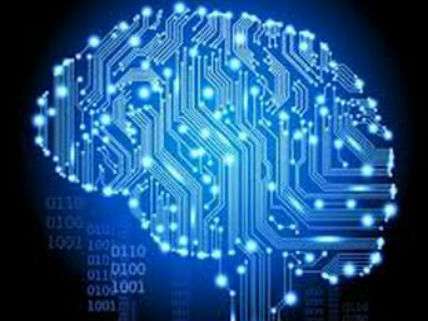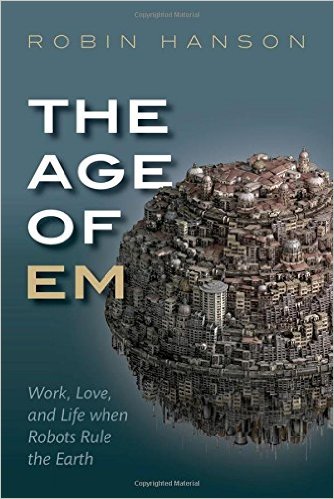Artificial Robot Brains Take Over the World
A review of The Age of Em: Work, Love, and Life When Robots Rule the Earth

The Age of Em: Work, Love, and Life When Robots Rule the Earth, Robin Hanson, Oxford University Press, 415 pp. $34.95.
Move over, humans; the emulations are coming and our world is going to get really weird. That's the premise of the George Mason economist Robin Hanson's fascinating new book, The Age of Em: Work, Love, and Life When Robots Rule the Earth, a worthy addition to the growing canon of visionary literature about exponential technological progress. The book tries to discern how the world will change when it becomes possible to upload human minds into computational substrates.
Hanson argues that three supporting technologies are required to achieve this: fast, cheap computers; fast, cheap brain scanners; and detailed and effective models of brain cells. Once all three become available later this century, it will be possible to scan a human brain and emulate it on computer hardware. At that point we'll enter the Age of Emulation—or the Age of Em, for short. And then what?
Since ems are instantiated on computer hardware, Hanson argues, they will be able to think much faster than human beings. A kilo-em, thinking 1,000 times faster than the human norm, would experience more than three subjective years with the passage of one objective day. An em who has three years to figure out a problem will always beat a human being who only has only one day to work on it.
Interestingly, Hanson anticipates that only a few hundred, perhaps as many as a thousand, human brains will be uploaded to create the em world. Since he thinks that most of them will be selected from among the most productive people on the planet, he believes that number will provide all the variation in values and productivity needed to run the em economy. Hanson also expects it to be easy and cheap to make as many copies of an em as desired, so he envisions an em society comprised of vast competing clans of ems—possibly billions, even trillions in each—all stemming from the original 1,000 uploaded brains.
The economy of these fast, highly productive emulations will grow enormously. Right now the human global economy doubles about every 15 years. For his baseline, Hanson expects the em economy to at least double in size every month. As a result, within 2 years the em economy would be thousands to perhaps billions of times bigger than the human economy.
What would em lives be like? Due to fierce competition and the ease of copying, most ems would live at essentially subsistence levels, earning just enough to pay for the energy and to rent the computational hardware needed to keep them running. The faster they run, the more they have to pay. Hanson also believes that ems would eventually die. Complex adaptive systems like human brains become inflexible over time, he argues, so the mental functions of emulated brains would become more fragile over time as their experiences piled up and they become less capable of learning new productive skills. Once an em is so inflexible that it can no longer earn its subsistence, it would "die" by being erased, either by choice or otherwise.

"When life is cheap, death can be cheap as well," suggests Hanson. "Today, erasing the last copy of some valuable software might be an enormous loss, while erasing typical copies costs very little. Similarly, erasing all copies of a trained em might be a great loss, but deleting one copy made a few hours ago could usually be seen as a rather small loss." Really?
Ems that run faster would mentally age faster. On the other hand, faster mental processing may enable an em to earn more than subsistence and pay for retirement. Thus, the alternative to death would a sufficient stream of earnings from investments to pay for running an individual's emulation at very slow, and thus very cheap, speeds. Or perhaps an individual em could archive himself or herself on an advanced version of a flash drive and be periodically resurrected to see what has happened while it was in storage.
For the most part, Hanson expects ems to live and work in virtual reality, though he thinks the ones who interact with the physical world may inhabit individual android bodies. In virtual reality, he writes, ems will "never experience hunger, disease, or intense pain, nor ever see, hear, feel or taste grime or anything ugly or disgusting." Since ems will be emulated human brains, Hanson expects the shared spaces in virtual reality to "often look recognizably like offices, bedrooms, bars, parks, plazas, auditoriums, elevators, etc., to evoke the behaviors considered appropriate in such places." The vast computational platforms that house em virtual reality will be agglomerated into em cities. Computation produces a lot of heat, so they'll need access to lots of cooling; therefore, Hanson predicts, em cities will likely be located closer to the poles and to seaside locations. (He speculates that the first one might emerge in Norway.) Em cities will not be hospitable to human beings, since they will be very hot and won't want to waste valuable space to accommodate puny humans and their physical needs.
Hanson expects em resources such as energy, cooling, and computer hardware to be earned and expanded on the basis of work productivity. Clans will specialize in certain kinds of work, and em teams may be composed members from various clans that prove most effective in achieving specific goals. Particularly successful work teams will be copied in their entireties as many times as needed. In general, ems will be copied and deployed just as they achieve their peak years of productivity, somewhere around 50 years of subjective age. He thinks productivity will be further enhanced when ems create "spurs" of themselves who function for a short while to complete discrete tasks. Such spurs may exist for just a couple of subjective hours and then "end"—die—once the chore is done.
Hanson spends a good bit of the book pondering the morals and mores of em society. One of his bigger conclusions is that he thinks it will be much more conformist and communal than current industrialized human societies. After all, most of any individual em's companions will be clan member copies that differ only slightly from themselves, or copies of ems from long-established clans with whom they work on teams.
Em society would feature lots of humanly recognizable characteristics, including love, friendship, sex, rituals, and conflict. Emulated human brains would still seek the intimacy of pair bonding and enjoy the company of amiable companions during their leisure time. Notwithstanding residual pair bonding instincts, some adventurous ems will perhaps seek sex with others who specialize as "open source lovers" endowed with extraordinary erotic skills. Hanson also thinks many ems will harbor religious beliefs, although some clarifications to doctrine will be necessary. For example, Christians would have to determine whether "copies share sins, or if an em sins when it splits off a spur who then sins, especially if that sin was foreseeable."
Em civilizational stability is not guaranteed. Em society could experience conflicts between competing em cities, between fast and slow ems, between rich and poor clans. Hanson doesn't expect copies and spurs to resist being "ended," but that seems like a huge potential source of conflict to me. After all, each copy and spur would be fully aware emulations of human brains with identities of their own. On the other hand, endowed by their originators with no more energy and computation time than needed for their assigned tasks, would-be rebels would have little scope for figuring out how to prevent themselves from being erased. Hanson suggests that humans like me might "be mocked for their squeamishness regarding em death."
What becomes of the biological world? Initially, human beings who start out owning capital and other resources will do well from investing in the skyrocketing growth of the em economy. Unable to compete with ems, human beings will retire to live off of their investments. But this happy state won't last long, as wilier ems outcompete our standard human brains stuck in standard human bodies. Resources will flow ever more strongly toward em-controlled companies and institutions. It is possible that the human economy will be so paltry in comparison to the vast wealth created by ems that they will simply won't be bothered to buy it all up. But Hanson thinks "the long-run prospects for the natural world look poor." While ems will exist mostly in a few dense cities, Hanson expects that "the descendant economies could fill the Earth within a few objective decades."
Descendant economies? "The em era may plausibly last only a year or two in objective time, after which it is likely to be supplanted by yet another era, as different from the em era as it is from our time," argues Hanson. What sort of era might follow the Age of Em? One dominated by artificial superintelligence (ASI) not based on emulating human brains. Hanson suggests that the exponential growth in wealth and innovation in the em economy could plausibly bring the development of self-improving ASI within two objective years. With ASI, all bets are off.
So that's one way brain emulation might evolve. Other futurists have projected other pathways. The technologist and transhumanist Ray Kurzweil, for example, has outlined a future in which human beings meld with their ceaselessly improving computational and perceptual technologies over time. Think of it as an age of creeping cyborgization, where the personalities and intellect of each biological human being migrates progressively onto digital platforms. The MIT artificial intelligence guru Marvin Minsky has suggested it will become possible this century to upload the minds of 10 billion people onto a computer that occupies a few cubic meters and costs only a few hundred dollars to run. Inside such a computer, emulations could create virtual worlds, conflicts, and narratives vastly more interesting than anything outside its confines. Perhaps emulations would stay home and play endlessly fascinating video games. While Hanson argues that a straight jump to artificial superintelligence is unlikely, the Oxford philosopher Nick Bostrom thinks it's both possible and extremely dangerous.
If Hanson has much of his baseline right, what should we make of the world he's imagined? I guess it depends on whether you think of ems as our posterity or as alien replacements.


Show Comments (206)